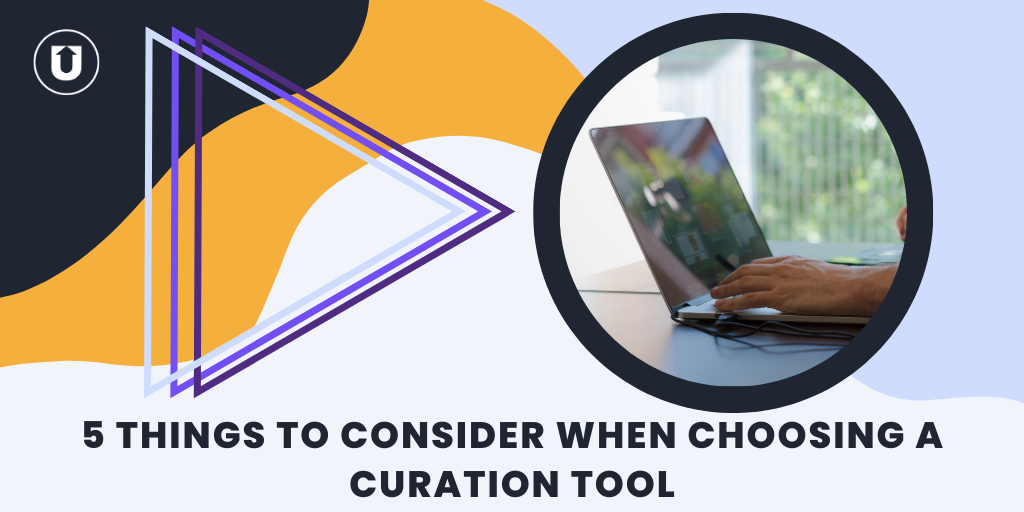A More Efficient and Effective Way to Curate Content

Content curation has become an essential process for any marketer, thought leader, or social media influencer.
However, now that there is such an overwhelming amount of content being created, shared, and repurposed, it is important to invest in an intentional curation process that will serve both you and your network, instead of simply contributing to the noise.
Even with an intentional strategy though, current methods for curating content can be inefficient and time-consuming.
By better understanding the true purpose of curation and utilizing streamlined tools and ethical strategies, content curation can become a medium for better conversations, rather than an excuse not to engage.
First, let’s talk about what curation actually is and why content marketers in particular see it as invaluable to their strategy.
What is curation?
You may think of a curator as someone who acts as a “custodian” of art at a museum, for example.
These curators, however, don’t just haphazardly display any art in any order in any room.
There’s a great deal of thought that goes into which pieces to display, especially in relation to one another, and they are often grouped by theme, time period, artist, medium, or expression. Curators carefully select the artwork in order to convey a certain feeling or connotation.
Knowing this, it’s no surprise that curation is defined as “to select, organize, and present, typically using professional or expert knowledge.”
When applied to content curation specifically, a curator–anyone who is purposefully sharing content with an audience–carefully chooses articles, blog posts, rich media, and social statuses that are of particular interest, organizes them, and shares them with their networks, friends, and/or colleagues.
The key here is choosing the best, most-relevant content that connect with you and your niche and with one another and then adding your own commentary–your point of view–in the sharing process.
Choosing content that seems interesting and then just hitting tweet or post only contributes to the noise; being intentional and contributing your voice alongside the content positions you as an niche expert or go-to thought leader.
Centerline Digital did an excellent job recapping content curation quickly, highlighting how the presentation of the material is what really delivers meaning to your audience.
The Dangers of Content Curation
It’s important to note that curation done incorrectly can do more harm than good for your brand or business.
Too often people treat curation as a “set it and forget it process,” using social media schedulers such as Buffer and Hootsuite to send out their discoveries to their audience.
Using these tools is smart and seamless, but if you’re just scheduling content just because, not adding your own perspective, throwing out content randomly, or not following up with interactions as a result, you’ve missed the point.
Curation is not meant to serve as an aggregator of content.
Additionally, be careful not to let curation discourage you from creating your own content.
Finding your balance between creation and curation can take some trial and error, but your audience wants to hear your own thoughts and ideas, too, not just what you think of others’.
Self-promoting too often can be off-putting, but the inverse is also true (and can drive precious traffic away if you’re not balanced!).
Remember, content curation should be seen as a tool to spark conversations, not as a replacement of interaction and your own creation.
Deciding What Content to Curate
Sharing a variety of types of content, from news articles and blog posts to rich media and social posts, keeps your feed interesting and refreshing, so be sure to consider the medium when organizing your selected content.
Too much of one type of content can seem redundant and almost robotic.
Even more important than medium, however, is the quality and relevance of the content you are curating. Ask yourself the following questions:
- Is this content published by a reputable source?
- Will my audience be informed or entertained by this content?
- How does this content connect with my own content?
- Does this content offer a unique perspective on a topic within my niche?
- Will I be able to add my own point of view/commentary to this content?
You don’t have to curate ALL THE THINGS (in fact, you shouldn’t), so use these questions to make sure you’re sharing only the most effective content.
Related Post: 9 Ways Curated Content Can Help You Meet Your S.M.A.R.T. Goals
A More Efficient Way to Curate
Current methods of curation typically involve multiple processes and tools.
The search for good content starts with Google searches and Pinterest scrolling that involve endless pages of broad results.
The content that does stand out is then Pocket-ed or bookmarked and then when it comes time to schedule, it’s added to Buffer or Hootsuite.
All of these tools and platforms are wonderful and useful, but there are a few alternative strategies and platforms that can simplify this process, while also adding value to your curation.
Turn to your newsfeed first.
Chances are you already follow individuals or brands who are generating high-quality, relevant content that others in your network would enjoy.
Not only will you have plenty of fodder for curation, but you will also fortify those relationships by exposing their work to a larger audience, adding your own perspective to their content, and starting conversations that can lead to other opportunities (perhaps even collaboration).
Streamline your sources.
If you prefer to pick and choose your own sources and want to compile them into one place, add their RSS feeds to an RSS Reader like Feedly.
You’ll still have to click into each article, but you can share directly to social media or add them to your Buffer, Hootsuite, and more. This allows you to look at only the sources you already know and trust and stay on top of the content they are producing.
Use a product designed specifically for discovery and curation.
Often times, Google searches provide only broad results or content suggestions that have great SEO thanks to virality.
Even more likely, the content shared on social media has probably already been shared many times across your network.
Using a content discovery tool like UpContent will eliminate this endless scrolling and resharing of already-viral content. With multiple search queries per topic, you can get exactly the kind of content you’re looking for from the most pertinent and authoritative sources in your niche. Y
ou can even sort your results by relevance, recency, shareability, and influence and find out what subtopics fall underneath your main topic. Your results can then be shared directly or added to Buffer or Hootsuite.
One Last (and Most Important) Step
So, you’ve found some awesome content your audience will love and you’ve found the tool that works best for you.
Exciting! Now, before you click that post button, don’t forget that it’s not enough to just share the title and link to that killer news article.
If you watched the video above, you’ll recall that how you present material is just as important as the quality of the material itself.
Because you’re sharing that content, you obviously have some sort of connection with it and so will your audience. Take advantage of the opportunity to get more out of the share than just a few clicks.
- Add your perspective on the topic. What do you have to say about this piece of content?
- Ask a question. What do you want to know more about after reading this content? Now you’ve given your audience even more opportunity to reply and start a conversation.
- Provide feedback. Reply to any questions the author may have posed or shed some insight on the topic.
- Don’t forget to tag the author and/or someone who also can weigh in. Not only is this just good ethical behavior, but it can open the doors to valuable conversations and connections.
By actively participating in your own curation, you remain just as strong of a presence as the content you’re sharing.
By eliminating the time-consuming and inefficient nature of curation with the right tools and strategy, you can now use content curation as a means for positioning yourself as a go-to leader and sparking the important conversations you want to have.



